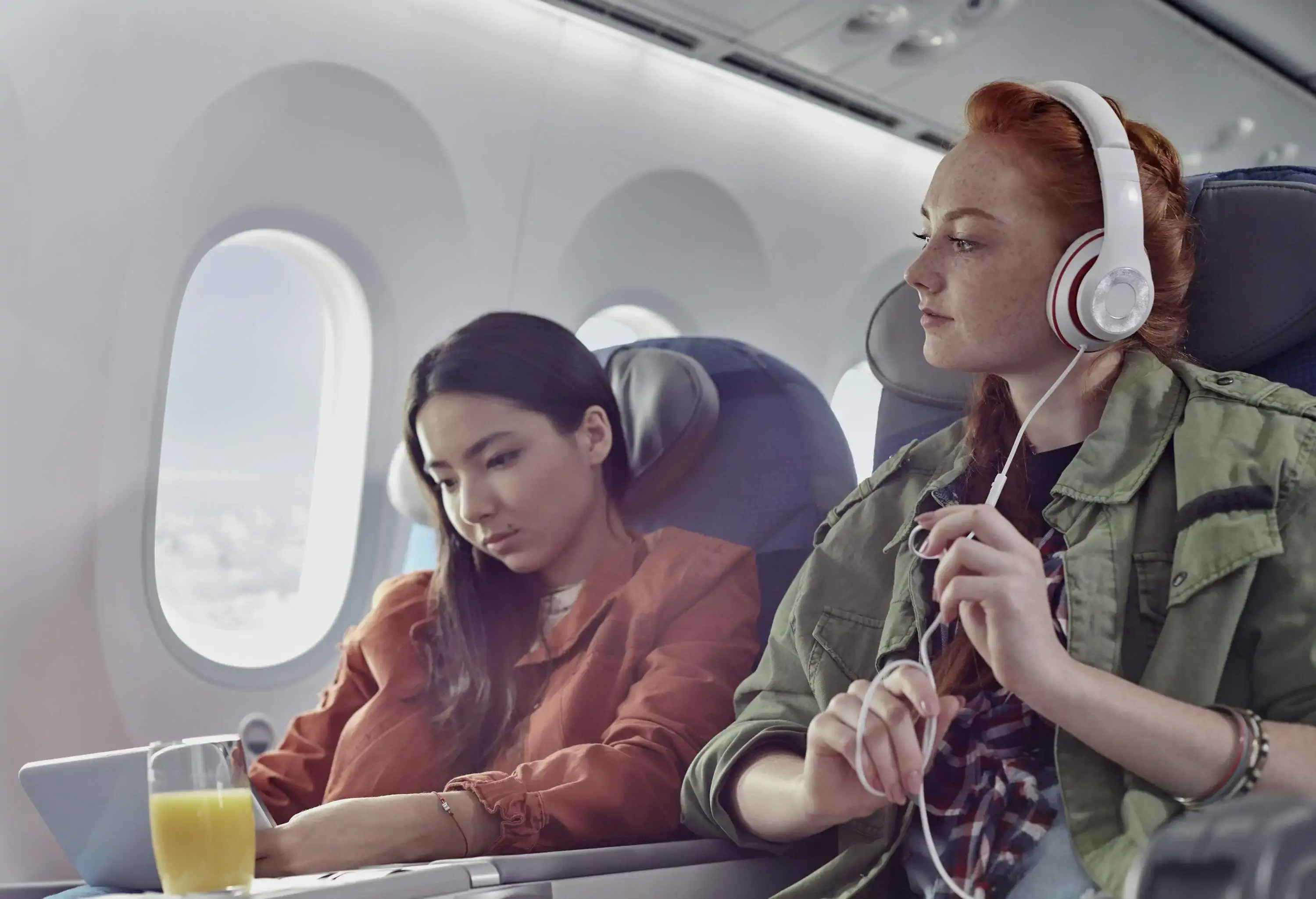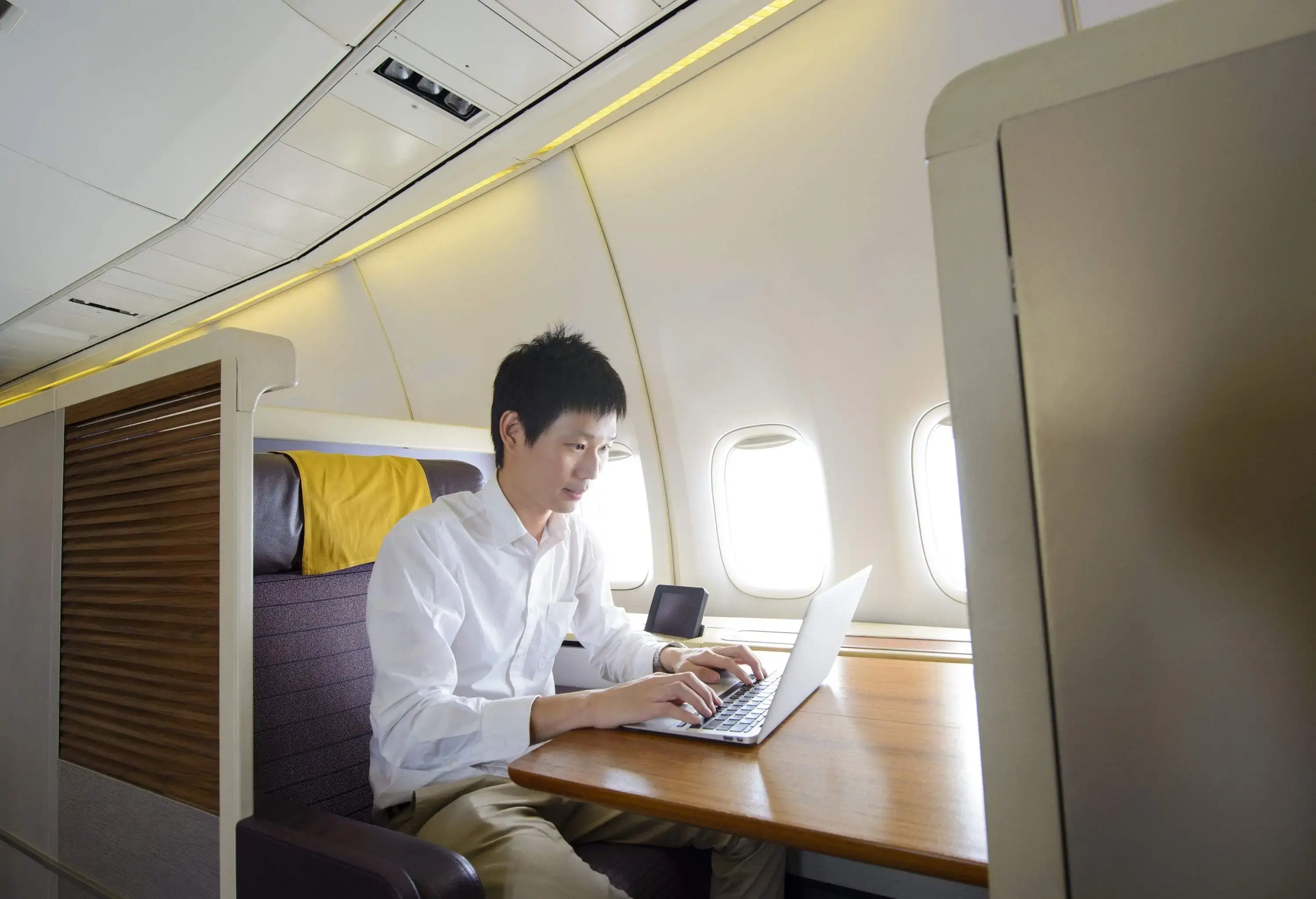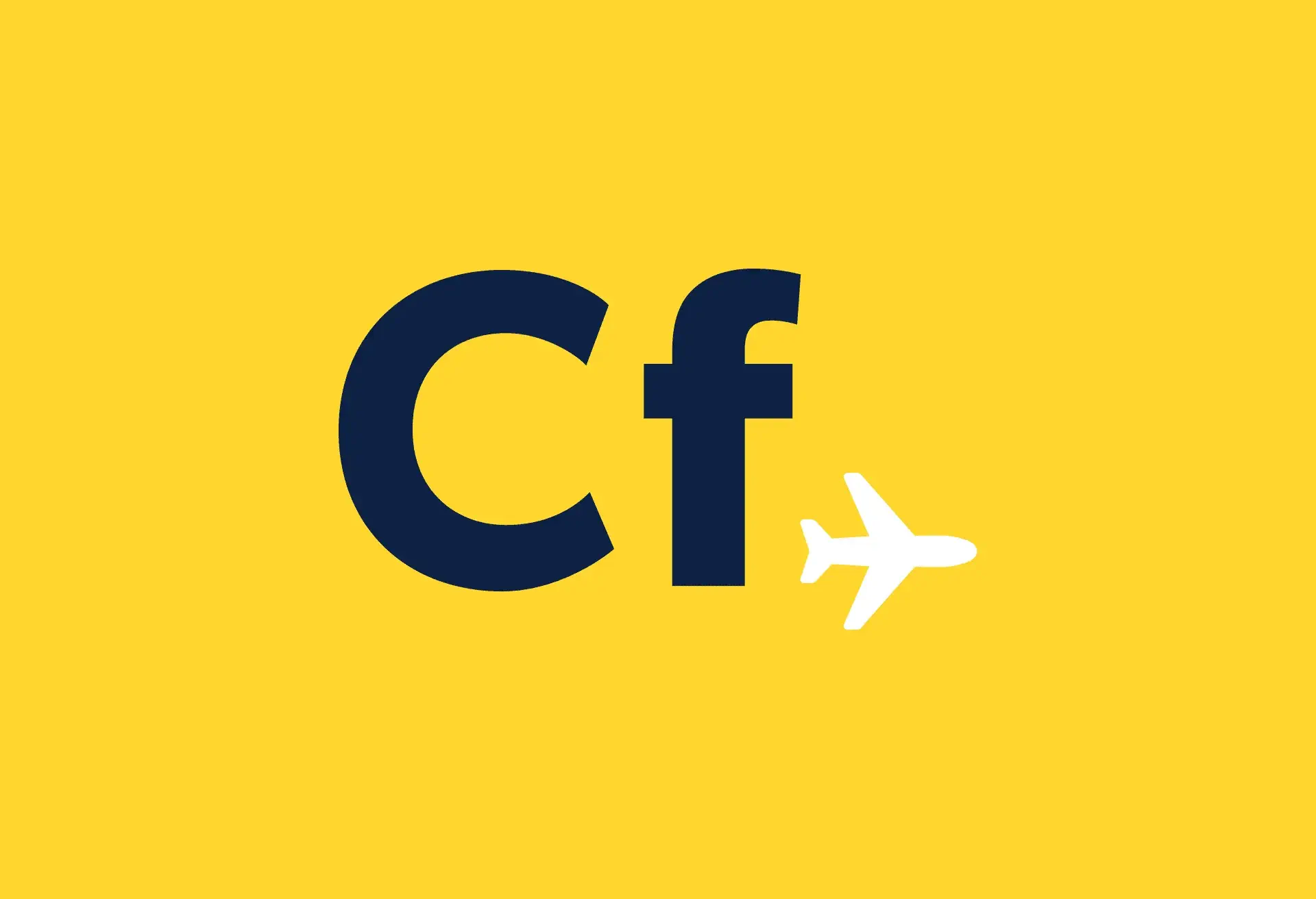Whether you’re a first-time skier looking to conquer the bunny slopes, a snowboarder hoping to tear it up, or a seasoned skier who hurtles down Black Diamonds, getting to your snowy destination with gear in tow can be a challenge.
From finding the right bag to navigating your airline’s policy on ski equipment, there can be a lot of headaches that come from traveling with skis. Our 10 savvy ski tips will get you from your flight to the slopes to après ski as quickly and smoothly as possible.
Price it out
Some airlines count a ski bag and boot bag as one piece of checked baggage while others do not. Confirm your airline’s policy on checked baggage and ski equipment before you book. If you’re flying with multiple carriers, check with each carrier. You can use our chart below for quick reference, but always call the airline to confirm as rules can change.
Call ahead
Contact the airline ahead of time, either by phone or by social media, to confirm skis and ski equipment can be checked on the flight. If your travel includes multiple airlines, different restrictions may apply, so reach out to each airline to verify details.
Bag it
Before you start packing, make sure you are using the appropriately sized ski and snowboard bag to transport your gear. When traveling with skis and snowboards, decide whether you want to invest in a wheeled bag or a non-wheeled bag. You’ll get an extra workout with the cheaper non-wheeled bag, but you’ll cruise more comfortably through long airport terminals and parking lots with the (albeit, more expensive) wheeled options. A well padded ski bag with wheels keeps your equipment protected during your travels while making it convenient to transport. Since weight is a factor for any kind of checked luggage, look for a lightweight bag that won’t add too much to your bag’s overall weight.
Keep it light
Ski equipment is subject to the same weight restrictions as all other baggage, so if your airline charges extra fees for luggage that is more than 50 pounds, you might be paying an extra price.
Here are some packing tips:
- Remove the binding from the skis to make your ski bags lighter, as bindings can be carried on.
- If you pack ski clothing in your boot bag, most airlines will charge the boot bag as a separate bag. (If you have only your boots in the bag, many airlines count your boots and skis or snowboard as a single item of luggage.)
- Bring your boots on board to lighten the load when airlines require all ski gear be packed in one bag.
- Cover the tips of your ski poles with tip covers or wrap foam pipe insulation around the tips and hold it in place with a rubber band to prevent the poles from tearing the ski bag.
- Attach a luggage tag with your name, address, phone number and email to the outside of your bag.
- Place a piece of paper or a business card with your name, address, phone number and email inside the bag.
Take a selfie
Take a photo of your checked baggage before your trip in case the bag is lost or damaged.
Give it time
Most airlines advise allowing extra time to check ski equipment. For example, British Airways advises passengers to add an additional 15 minutes.
Get status
Love to ski? If you fly often, it pays to book your travels with the same airline. Rack up enough miles in a year and you’ll earn frequent flier status that could include free checked bags, meaning your skis could fly free.
Skis on board
Getting your gear to and from the airport can be a challenge. If you don’t happen to have a car that is large enough to stow your skis, one option is to rent a car with a ski rack or roof box. If you’re buying a ski rack, look for ones that accommodate your skis and snowboards in their bags. Roof boxes are more expensive but offer more protection.
Rent it
Travel light and leave the skis and snowboards at home. Most resorts and ski schools rent equipment, including skis, poles, snowboards, boots and helmets. Companies like GetOutfitted let skiers and snowboarders order online, have the gear shipped for free to hotels in the U.S., and ship the equipment back in prepaid packaging from the hotel front desk. Black Tie Ski Rental Delivery also delivers gear to your hotel, and a personal concierge custom fits the equipment at 39 resorts in the western U.S. Plus, if conditions at the slopes change, you can rent the exact skis you need for the perfect slope session. Don’t like the idea of renting ski boots worn by someone else? Bring your ski boots and just rent skis. And, if you don’t want to travel with heavy ski coats and snow gear, companies like GetOutfitted and Mountain Threads let you rent outerwear too.
Ship it
Leave the heavy lifting to someone else. Companies like Luggage Free, Luggage Forward and Ship Skis let travelers pack lots of gear and travel lightly. Plus, your gear arrives before you do, helping travelers bypass the luggage carousel and head straight to the mountain.
Carrying skis and snowboards on flights
Air Canada: Ski equipment counts as one piece of luggage toward baggage allowance. One boot bag is permitted per passenger and won’t count as a piece of checked baggage if it’s carried along with skis or snowboard and it contains only boots. There is no extra charge to check skis or a snowboard when traveling between Canada and Europe, the Middle East and Africa (between Nov. 1, 2016 and April 30, 2017). Baggage fees may apply for travel within Canada, between Canada and the U.S. and all other destinations.
One or more sets of skis carried together in the same container count as one piece of checked baggage. Skis and poles must be packed in a rigid and/or hard shell case specifically designed for shipping. If carried separately, a set of ski poles will count as one piece of checked baggage. No oversize charge applies to skis or snowboards, but overweight charges may apply to skis.
Air France: Ski equipment is considered as a standard checked baggage item and is included at no extra charge in the baggage allowance (except for Light and Basic fare tickets) if it is the only baggage that a passenger wants to check (or one out of the two pieces of baggage allowed for the Business and La Première cabins). Fees to check an extra bag vary by route, but cost 20 percent less when purchased online.
One piece of baggage includes one pair of Alpine or cross-country skis, one pair of poles, and one pair of boots, or one snowboard and one pair of boots. Items must be in a travel case that does not exceed 300 centimeters or 118 inches in length. Ski or snowboard boots can be packed in a separate bag and are considered as one standard checked baggage item and their transport is included at no extra charge in the baggage allowance.
Alaska Airlines: Ski equipment counts as one piece of luggage toward baggage allowance. A fee applies to equipment over 50 pounds or 115 linear inches.
One piece of baggage includes one pair of skis with poles or one snowboard, plus one boot/helmet bag. If boots and/or the helmet are checked in a bag that also contains clothing or additional items, standard checked baggage fees will apply to the bag. Ski/snowboard equipment may exceed 62 linear inches but no more than 115 linear inches without incurring an oversize fee.
Allegiant Air: Ski equipment is considered a checked bag with all applicable fees applied per person, per bag, per segment. Applicable fees are applied for bags exceeding the 40-pound weight limit and 80-inch size limits. Baggage weighing more than 100 pounds is not accepted.
One piece of ski equipment includes one pair of skis or one snowboard, one pair of poles and one pair of ski or snowboard boots encased in a proper container.
British Airways: Ski equipment counts as one piece of luggage toward British Airways’ free checked baggage allowance. Passengers travelling on a hand baggage only (Basic) fare or whose checked baggage allowance includes one bag only, the passenger will need to pay extra to take the ski equipment. Items over 23 kilograms may incur an overweight baggage charge.
Passengers can check ski and snowboarding equipment up to 190 centimeters or 75 inches in length, provided it is packed in a recognized ski or snowboard bag, ski poles are packed with the skis and boots are packed separately from the skis or snowboard.
Delta Air Lines: Ski equipment counts as one piece of luggage toward baggage allowance. Fees apply if the combined weight of the ski/pole bag or snowboard bag and boot bag exceeds 50 pounds, then an excess weight charge will apply. If linear dimensions exceed 203 centimeters or 80 inches, then excess size charges will apply.
Ski equipment counts as one piece of luggage toward baggage allowance that contains one ski/pole bag and one boot bag or one snowboard bag and one boot bag.
JetBlue Airways: There is no additional charge for ski and snowboard equipment; however, one item of equipment counts as one checked bag. Skis and snowboards are exempt from the standard size requirements of 62 inches but should still follow weight and other equipment guidelines. Passengers are charged an excess baggage fee if the snowboard exceeds the checked baggage weight requirements. Ski and snowboard equipment are not accepted on flights to/from the Dominican Republic.
One checked baggage of ski equipment includes one pair of skis, one pair of poles and one pair of ski boots or one snowboard and one pair of snowboard boots. Ski boots or snowboard boots, if packed separately from skiing equipment, must be in a ski boot bag to be considered part of the one piece of checked baggage.
Southwest Airlines: Ski equipment counts as one piece of luggage toward baggage allowance. If the ski equipment exceeds 50 pounds in weight, excess weight charges may apply.One checked baggage of ski equipment includes one pair of skis or one snowboard, one set of poles and one pair of ski/snowboard boots packed in up to two proper containers that contain one set of snow skis, ski poles and ski boots. The ski equipment counts as one item, even if the equipment is packed and tagged separately.
Spirit Airlines: Ski equipment is charged as one standard checked bag. Ski equipment that weighs more than 18.1 kilograms or 40 pounds is considered overweight and excess weight charges will apply. A limited liability release form is required to be signed when traveling with skis or snowboards.
One checked baggage of ski equipment includes one pair of skis or one snowboard, one set of poles and one pair of boots.
United Airlines: Ski equipment counts as one piece of checked luggage. If the combined weight of the ski bag and boot bag is more than 50 pounds, applicable overweight charges apply. A boot bag without an accompanying ski bag is considered one bag and baggage fees apply. Ski and boot bags that contain other items in addition to or in place of appropriate ski equipment are subject to the applicable overweight checked baggage service charge.
Passengers can check one piece of ski or snowboard equipment per person. Ski equipment includes up to two snowboards in one bag or up to two pairs of snow skis and associated equipment in one bag plus one ski boot bag.
Virgin America: Ski equipment counts as one piece of luggage toward baggage allowance as long as the skis, poles and boots or snowboard and boots are enclosed in a single container or travel bag. Checked bags cannot exceed 62 inches (calculated by adding the length plus width plus height). Excess size bags cannot exceed 80 linear inches or weigh more than 45 kilograms or 100 pounds.
Ski equipment, including poles and boots, must be enclosed in a container or travel bag.
Virgin Atlantic: Ski equipment is transported as part of a traveler’s checked baggage allowance for all tickets purchased after August 31, 2016. Ski equipment is transported for free in addition to the checked baggage allowance for bookings made prior to August 31, 2016 as long as the gear doesn’t exceed 50 pounds.
Ski equipment is considered as one pair of skis, poles, a mask or helmet and one pair of ski boots. Snowboard equipment is one snowboard, a helmet and a pair of boots and bindings.
Ready to hit the slopes? Let us help you choose you next ski destination with our “Top 10 alternative ski resorts in North America.”
Main image: iStockPhoto/MilosStankovic





